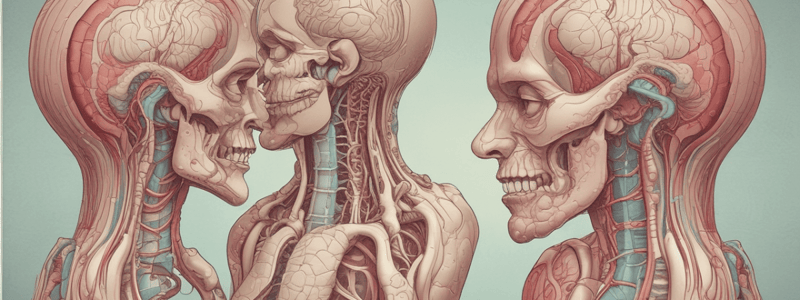Podcast
Questions and Answers
What is the function of the internal anal sphincter in the process of defecation?
What is the function of the internal anal sphincter in the process of defecation?
- To relax and allow the passage of feces
- To secrete enzymes for chemical digestion
- To inhibit the smooth muscles and prevent defecation (correct)
- To stimulate the parasympathetic signals in the sacral region
What is the main function of mechanical digestion in the large intestine?
What is the main function of mechanical digestion in the large intestine?
- To secrete enzymes for chemical digestion
- To mix food with bile
- To break down proteins into amino acids
- To absorb electrolytes and water (correct)
What is the primary source of vitamin K and B in the large intestine?
What is the primary source of vitamin K and B in the large intestine?
- Gastrocolic reflex
- Bacterial fermentation (correct)
- Mechanical digestion
- Gastroilial reflex
What is the approximate time it takes for feces to form in the large intestine?
What is the approximate time it takes for feces to form in the large intestine?
What is the function of the gastrocolic reflex in the large intestine?
What is the function of the gastrocolic reflex in the large intestine?
What is the primary component of feces?
What is the primary component of feces?
What is the primary function of the pelvic floor muscles in the anus?
What is the primary function of the pelvic floor muscles in the anus?
What is the effect of the parasympathetic signals on the internal anal sphincter during defecation?
What is the effect of the parasympathetic signals on the internal anal sphincter during defecation?
What is the final stage of the large intestine where feces is formed?
What is the final stage of the large intestine where feces is formed?
What is the origin of the dead epithelial cells present in feces?
What is the origin of the dead epithelial cells present in feces?
What is the primary stimulus that triggers the defecation reflex?
What is the primary stimulus that triggers the defecation reflex?
What is the purpose of the ileocecal valve in the large intestine?
What is the purpose of the ileocecal valve in the large intestine?
Flashcards are hidden until you start studying
Study Notes
Large Intestine Structure
- The large intestine consists of the ileum, ileocecal valve, ascending colon, transverse colon, descending colon, sigmoid colon, rectum, and anus.
- The rectum is the last 8 inches of the large intestine.
- The anus is the last inch of the large intestine and has two sphincters: the internal sphincter (involuntary) and the external sphincter (voluntary).
Mechanical Digestion
- The large intestine absorbs water and electrolytes through mechanical digestion.
- Hostral churning absorbs electrolytes.
- The gastroilial reflex triggers the emptying of the ileum when the stomach is filled or triggered.
- The gastrocolic reflex triggers the emptying of the colon when the stomach is full.
Bacterial Fermentation
- Bacterial fermentation occurs in the large intestine, causing odors and releasing vitamins B and K.
- Bacteria secrete enzymes that cause chemical digestion.
Feces Formation
- It takes 3 to 10 hours to form feces.
- 90% of the water has been absorbed from the feces.
- Feces contain dead epithelial cells from the lining of the large intestine or entire digestive tract.
Defecation
- Defecation starts with the activation of stretch receptors, signaling the sacral region of the spinal cord.
- The defecation reflex is activated in the sacral region.
- Parasympathetic signals from the sacral region inhibit the smooth muscles within the internal anal sphincter.
Studying That Suits You
Use AI to generate personalized quizzes and flashcards to suit your learning preferences.




